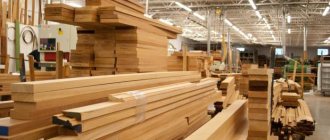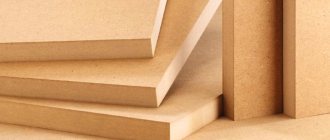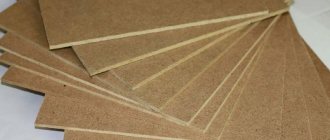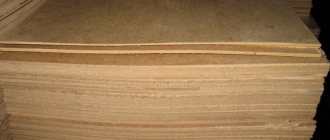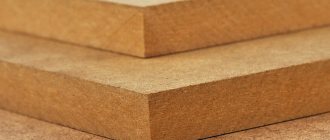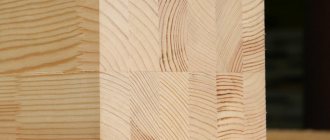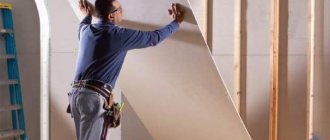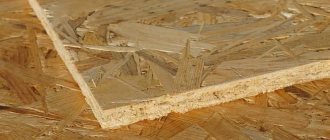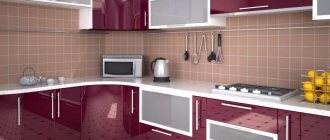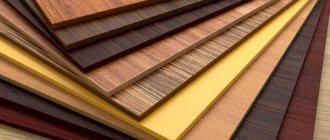Chipboard (chipboard) is a currently popular building material. This success is facilitated by the appearance of the sheets, some characteristics improved in comparison with wood, as well as their relative cheapness. Among the improved chipboard parameters, the following stand out:
- resistance to wood insect pests;
- higher resistance to cracks and various defects;
- easier sheet processing;
- higher fire resistance
- availability of sheets: compared to wood, it is cheaper.
It is these characteristics that have made chipboard sheets one of the most used materials in various fields. In addition, the production of chipboard, although labor-intensive, is very profitable and profitable, because it can pay for itself in an average of 1-1.5 years.
What it is?
Chipboard is a sheet composite material produced by pressing sawdust and shavings at high temperatures with a non-mineral binder and the introduction of various additives, which are necessary in various cases to improve certain properties of the resulting sheet. The production of this material is quite expensive, but at current prices for the finished product, the purchased equipment pays for itself in 1-2 years.
Depending on different indicators, there are several classifications of chipboard. Some classifications are given below.
Main types
The CIS GOST documentation identifies the following characteristics for classification:
- Based on the number of layers, chipboard is divided into single-layer, two-layer, three-layer and multi-layer. Moreover, the trend is this: the greater the number of layers, the more dense and durable the resulting slab.
- By emission class. Emission determines the amount of formaldehyde that, when added during production, is released into the air from 100 g of slab. There are 2 classes: E1 and E2, while the first is more environmentally friendly, harmless to people, the content of harmful substances in it is less than 10 mg. Another class contains more than 10 mg of formaldehyde. Boards of this class are suitable for use in construction and production with good ventilation or outdoors. There is also a certificate for chipboard that confirms its emission class. The certificate is issued by a special body, has an established model and is distributed throughout the CIS. The current standards for assessing the toxicity of formaldehyde in Europe differ from those adopted in the CIS countries.
- Based on the density of chipboard, slabs are distinguished with low density (550 kg/m³), with medium density - 550–750 kg/m³, with high density - more than 750 kg/m³.
- There are 2 types of chipboard, P1 and P2, and depend on the physical and mechanical characteristics of the sheets: resistance to bending, curvature, hydrophobicity, etc. In this case, type P1 is intended for use in conditions of absence of humidity, and P2 is intended for use indoors, including including furniture production, for use in conditions without humidity.
- There are 2 grades based on the characteristics of the external condition of chipboard sheets: grade I (without flaws or almost without defects), grade II (large defects of the top layer are allowed). For slabs with significant deficiencies, the name without grade is also used; it can be used in repair and construction work.
- The outer layer of chipboard is divided into sheets with a fine-grained top layer (coating with polymers is acceptable), regular (can be covered with veneer) and coarse-grained (used for repair and construction work)
- There are also sanded (Sh) and unsanded (NS) chipboards based on the level of processing of the outer layer.
When will the investment pay off?
The payback of the enterprise will depend on the capacity of the chipboard production line that will be purchased for the workshop, on the prices of raw materials and the finished product. In your business project, provide all the necessary profitability calculations. To find out when the costs will pay off, you need to know the size of the initial investment. They will amount to at least 10,500,000 rubles. This may include:
- Purchase and commissioning of main and additional equipment – 10,000,000 rubles.
- Creation of inventory – 500,000 rubles.
- Registration of an enterprise – 50,000 rubles.
- Preparing the premises - 300,000 rubles.
Monthly costs (rent, wages, tax deductions, transportation costs, utility bills) will be approximately 600,000 rubles. The chipboard production machine will produce up to 100 sheets (1830*2440*16 mm) of material per shift (3000 sheets per month). By selling all manufactured products at a price of 750 rubles per sheet, you can earn up to 2,250,000 rubles per month. Taking into account monthly costs and production costs (450 rubles/sheet), the net profit in this case will reach 300,000 rubles. These are excellent profitability indicators, since all costs will be recouped after 3 years.
What is chipboard made from?
To make chipboard, three components are needed: wood chips, a binder (most often resin or formaldehyde derivatives) and additives to obtain new properties.
Raw materials
The raw materials are various waste from wood processing, logging and sawmills. These include the following types:
- low quality round lumber;
- branch;
- cuttings;
- shavings;
- sawdust;
- low quality wood slabs or slabs;
- low-quality butt part of wood or bottom part;
- whip trimmings.
The importance and significance of making slabs becomes clear. From waste and low-quality timber, material is obtained that is suitable for the production of durable and high-quality products, and chip and sawdust processing increases the yield of wood processing by up to 90%.
Binder
In order for wood waste to stick together, a binder must be added to the mixture of raw materials. For the first prototype chipboard sheet, they used casein glue in 1887. And only 46 years later they came to use resins instead of glue as a binder. The first resins that began to be used in production were phenolic and urea. For the production of chipboards intended for external cladding, urea-formaldehyde resins modified with melanin are used as a binder. At the same time, their weather resistance will be low. To obtain chipboard with high weather resistance, phenolic resins or diisocyanates were added to wood raw materials.
In addition to them, resins such as phenol-cresol and xylenol-formaldehyde were also common. As a result, to speed up the hardening process, they began to add more concentrated derivatives of formaldehyde and sodium hydroxide to react with it. When caustic soda reacts with formaldehyde derivatives, an alkali is obtained and formaldehyde gas is released into the atmosphere. Therefore, they are not suitable for use in the production of chipboards for furniture and interior decoration. To reduce toxicity and emissions into the atmosphere, phenol and xylenol have been abandoned, and resins with a smaller volume of alkali formed, or without it at all, are being used. Currently, there are environmentally friendly resins that emit no more than 0.5 mg of formaldehyde per 100 g of slab into the atmosphere. Low-toxic mixtures are also used, which pose virtually no harm to the environment or health.
Special Additives
They are used only to add special characteristics to chipboard sheets. Often the volume of such additives is about 6–10% of the mass of wood particles.
Characteristics that can be obtained during the production of chipboard: fire resistance, hydrophobicity, increased strength. Additives that allow you to achieve the listed characteristics are fire retardant, water repellent, antiseptic.
Selecting a location
The space requirements for locating chipboard production will vary for a given scale. The general principle is this: for each stage (production of raw materials, production of slabs, processing of slabs) a separate workshop is required. They must be spacious enough for proper installation of equipment and organization of the production process. It is necessary to provide a separate room for storing finished products. A complete production line will require an area of at least 500 m2.
Chipboard production
The technology for producing wood boards consists of mixing wood raw materials with an adhesive agent and pressing under high pressure and temperature. The production cycle helps turn substandard viscous mixture into a finished product.
Equipment
The technological cycle of chipboard manufacturing is based on the use of simple and high-performance equipment, which is a single complex. The use of high technology on production lines is not mandatory, although setting up and maintaining the continuous production state of all machines on the line is a difficult task that cannot be solved in a standard way.
The chipboard production line includes:
- mixers - necessary to achieve uniformity of raw materials when mixing sawdust and a binder (a resin composite with a thermohardener, to which special substances can be added that give special characteristics to the slabs);
- devices for shaping - they form a viscous mixture of wood raw materials with a binder in portions for the production of boards;
- devices for pressing at high temperatures - necessary to ensure that the formed chipboard blank hardens under high pressure and temperature;
- cooling devices – responsible for accelerating the cooling of compressed sheets;
- devices for cutting edges - for removing the ends of slabs;
- grinding machines – give smoothness to the formed top layer of slabs.
In this case, the devices operate automatically, and quality management and support of system settings at a given technological level occur simultaneously.
Manufacturing technology
The chipboard production technology is a rather labor-intensive process, but with proper automation it does not require much attention and control from people.
First, the raw materials are processed. It includes such stages as: receiving or unloading chips; sorting chips by size; and purification from impurities. As part of the first stage, the wood is analyzed for its fraction: if it is small, then it is transferred further; otherwise it is crushed, after which it moves on. The second stage is sorting the chips by size. This is where the separators are divided into small and large parts and placed in different containers. For the surface layer, small shavings and sawdust are used, as well as grinding dust. Moreover, the inner layer contains these components up to 20% of the total mass. After purification from impurities, the resulting mixture moves to the second stage.
The second stage of the cycle is drying the resulting mixture. In this case, chips of different layers are dried separately in order to comply with humidity standards. Thus, the moisture content of the final mixture for the inner layer should be in the range of 2-4%, and for the remaining layers - 4-6%. In the production of slabs, convection drying is usually used.
After the chips have dried, stage 3 begins, during which the chips are coated with a binder or mixture. It is important that each individual chip is coated with the mixture to better bind into a single layer. In this case, it is also necessary to calculate the correct % of binder to avoid overuse. Both of these characteristics affect the quality of the final slab.
Forming the resulting viscous mass into a wood board shape. Molding devices are responsible for this, which precisely divide the carpet of the viscous mixture into portions, from which chipboard sheets will then be made. The main thing here is that the mixture is distributed evenly both in length and thickness, otherwise the quality of the slab will be lower.
Next, the portion follows to the press. There it is compressed at a pressure of 30-40 kg/cm2 and a temperature of 180–220 °C. At the same time, 2 types of units are common: extrusion and flat. As a result of pressing, an almost finished sheet of chipboard is obtained, but still hot.
The resulting chipboard board must be cooled for two reasons. The first is the high temperature after leaving the heat-pressing unit, the second is the difference in temperature and humidity between the layers, which is quite significant. Thus, the difference in humidity can reach up to 7-10%, which can cause internal stress, which, during subsequent hot processing of the board, can lead to deformation of the chipboard.
Therefore, what follows next is the cooling and cutting stage, during which the chipboard sheet is cooled to a temperature at which it is convenient to transform it further. Often, fan-type devices are used for cooling.
After the slab has cooled, it passes through the line first to the edge trimming device, and then to the grinding machine. The edge trimming device will bring the chipboard board to predetermined dimensions, and the grinding device will make the board surfaces smooth.
This completes the production process. Next, the chipboard slabs are either sent to be covered with protective films (laminate, veneer, and others), or are delivered to a warehouse and sent to consumers in this form. Before packaging, chipboards are sorted by grade.
Certificate of conformity
Within the industry, there are 3 areas of certification of products manufactured by chipboard production, carried out in three areas:
- compliance with the requirements of generally accepted standards (CIS Standard, GOST);
- fire safety compliance;
- compliance with environmental and sanitary requirements.
GOST 10632-2014 Particle boards. Specifications
1 file 198.92 KB
Milling
The production of internal shaped surfaces and external processing of corners is carried out using milling. The cutter is a toothed cutter having an arbitrary regular shape (cone, trapezoid, truncated figures, etc.). Unlike working with harder materials, chipboard is processed throughout its entire thickness to avoid chipping.
Before work, preparation is made, which consists of preliminary cutting out the contours of the planned figures with a circular saw or jigsaw. Processing is carried out using a manual or stationary milling cutter. In this way, cylindrical and oval holes of any size are obtained, ensuring the aesthetics of the finished product.
Making chipboard at home
It is also possible to produce wood-based panels within the framework of a subsidiary farm, however, with one limitation. The size of the chipboard boards will ultimately be up to 0.25 m2 (50 x 50 cm).
The production technology is the same, but reduced. All automated stages must be replaced with manual labor:
- Mix sawdust in a small container or bucket (10-15 l).
- Add the binder and completely saturate the sawdust with it.
- Press into shape.
- Compress the workpiece in special equipment at high pressure and temperature.
- Cool the resulting tile in air.
- Trim its edges.
The current state of the industry shows that chipboard production technology is constantly being improved, and the use of increasingly environmentally friendly and low-toxic mixtures as binders is growing. In addition, the consumption of slabs in various industries is constantly growing. Every year more and more new options for using wood-based panels appear.
Equipment selection
To obtain your own raw materials, you will need the following equipment:
- Waste storage.
- Chipper machine.
- Cutting and planing machines.
- Dryer.
- Mill.
Technological equipment for production includes the following components:
- Mixer. Designed for mixing raw materials and adhesive to obtain a homogeneous mass.
- Forming machine – for distributing mass among forming containers.
- Presses (pre-press and thermal press) compress the mass.
- Coolers designed to cool the resulting slabs that have undergone high-temperature treatment.
- Trimming machines (vertical and horizontal).
- Sanding machine for smoothing the surface and edges of slabs.
Scope of application of chipboard
Wood panels can be used both in the production of furniture and in the following cases:
- for the construction of parts of building structures;
- when creating enclosing barriers at construction sites;
- as a mold for casting concrete during repair and construction work;
- for creating structures on various sports grounds;
- as a subfloor substrate if several layers are planned;
- in the production of interior doors;
- used as flooring materials;
- used as wall and ceiling slabs;
- for covering wagons and other containers for storage and transportation;
- for the construction of exhibition racks and stands for advertising purposes;
- slabs are used as cladding for roof coverings.
In furniture production, this material is valued for its flexibility to change and bend, the different colors imaginable, ease and speed of assembly, and universal availability.
Marketing research
Selling products will not be a problem, but a serious approach to organizing a business will allow you to streamline its volumes and avoid possible miscalculations. Therefore, it is worth conducting marketing research on the market for similar materials in order to more accurately represent the situation in the region.
To do this, you can take the following steps:
- Determine the general need of enterprises for this type of product.
- To track offers of chipboard and its analogues already existing on the market.
- Think about building a marketing strategy for your enterprise (what will be the advantage of the product over others - quality, price, features of the advertising campaign, etc.)
- Consider additional opportunities: business combination, creative approach to advertising, system of individual discounts, etc.
Video on the topic:
Types of chipboard
